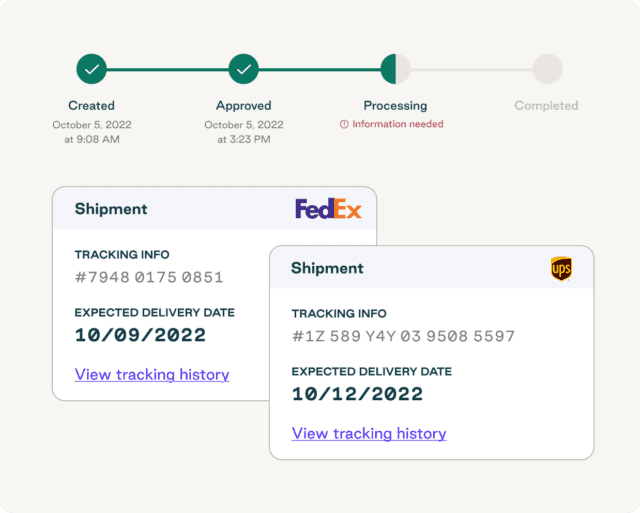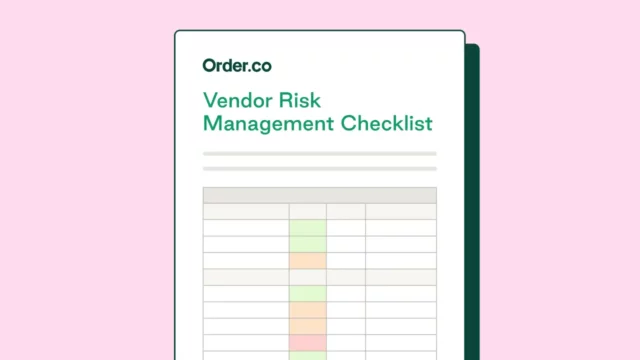10 Practices to Improve Your Retail Risk Management

10 Practices to Improve Your Retail Risk Management
Running a retail business means balancing tight margins, changing demand, and operational risks. Without the right controls in place, risks like data breaches, theft, uncontrolled spend, and supply chain disruptions can quickly undermine your processes, profitability, and customer relationships.
With a proactive approach to retail risk management and the right tools to support it, you can strengthen your operations, reduce exposure, and build a more efficient, resilient, and profitable retail business.
Download the free tool: Vendor Risk Management Checklist
Why retail risk management matters
Retail is full of risks. Without a plan to manage them, you sacrifice opportunities to grow in favor of damage control. Here's what happens when retail risk management goes south:
- Data breaches: The global average cost of a data breach in 2024 was $4.9 million, plus the lasting damage to consumer trust and future sales.
- Theft and fraud: Unchecked theft and fraud can also lead to million-dollar losses. Retail shoplifting incidents alone rose 93% from 2019 to 2023, according to the National Retail Federation. But fraud isn’t limited to customers—vendor fraud, such as inflating invoices or delivering substandard goods, can lead to significant losses.
- Inventory issues: Inaccurate inventory management can lead to stock shortages, waste, and missed sales opportunities, while also making it harder to detect losses due to theft, errors, or damage. In 2022, inventory shrink rose from 1.4% to 1.6%, which is enough of an increase to impact your bottom line over time.
- Safety liabilities: Unsafe conditions can lead to injuries, such as slips and falls, for employees and customers. In the US alone, private industry employers reported 2.6 million nonfatal workplace injuries and illnesses in 2023.
- Regulatory failures: Failing to uphold regulatory requirements, including cybersecurity standards (e.g., GDPR and PCI DSS), financial regulations, and customer safety standards, can result in significant costs and setbacks. For example, health catalog retailer Easylife was fined £1.48 million by the UK Information Commissioner's Office (ICO) for data protection and marketing violations.
These threats erode profit margins through fines, lost sales, and waste. The sooner you centralize risk management to take control, the faster you can scale your organization. If you're not sure where to start, a vendor risk management checklist can help you assess your current processes and identify potential gaps.
5 strategies for mitigating core retail risks
Rather than crossing your fingers and hoping you don't encounter retail risks, tackle them head-on with a proactive retail procurement management approach.
1. Strengthen data security
Cyberthreats are evolving fast, and you can't afford to let your procurement process fall behind. The key to responsible cybersecurity and cloud security is adopting best practices and new technologies to address emerging threats before they arise.
Prioritize tech and processes like:
- Data encryption
- PCI DSS-compliant standards for payments
- Employee training to identify phishing and widespread threats
- Data access limits for employees and users
- Multi-factor authentication (MFA) for secure logins
When choosing a risk management platform, be sure you opt for one that incorporates top security standards. Look for solutions with controlled user access, audit logs, and secure data storage for transactions, vendor information, and SSO integrations. These features help you stay compliant and secure, even as new threats emerge.
2. Tackle theft and fraud
To combat theft and fraud, your retail business must implement both physical and cybersecurity measures, along with strong process controls. Brick-and-mortar stores can add security cameras, RFID tags, and staff training to spot shoplifting. Ecommerce companies can strengthen authentication protocols and payment processing through firewalls, encryption, and continuous monitoring for suspicious activity.
Software tools can help prevent internal, procurement-related fraud, such as unauthorized purchases, duplicate payments, and invoice manipulation through spend controls. With audit trails and built-in budget limits, it becomes easier to catch internal fraud before it affects your business's financial health.
3. Implement robust inventory checks
If you fail to order stock or miscount your inventory, you could face out-of-stock situations that impact your revenue. To stay on track, build a routine for ongoing inventory checks, including:
- Regular cycle counts
- Consistent audits and reconciliations to align your records with actual stock levels
- In-depth root-cause analysis to discover why discrepancies exist
Vendor management also plays a role in inventory control, as missed deliveries, quality issues, and supply inconsistencies can all throw off inventory balance. Software helps you organize and manage your vendor relationships, enabling you to monitor performance and hold partners accountable.
4. Put customer and employee safety first
Safety isn't optional for retail environments. It protects your people, your reputation, and your bottom line. Whether you're running a physical store or a warehouse, put clear protocols in place to prevent accidents and reduce risk:
- Keep aisles clear and clean up spills immediately
- Regularly inspect shelves, equipment, and signage
- Schedule routine safety audits based on risk level
Consider your procurement practices as well. Work only with vendors that meet safety standards and regulations for the goods and services they provide. Review their certifications and hold them accountable to the same standards you set internally.
5. Verify regulatory compliance
Like cybersecurity standards, you should focus the same attention on other types of governance requirements, such as accounting and reporting.
With the right software solution, you can embed controls in each layer of your risk management workflow:
- Audit readiness: Capture every approval and payment with timestamps and detailed records. A built-in accounting trail supports faster reporting and simplifies external audits.
- Procurement risk controls: Restrict purchases to pre-approved vendors and gain oversight of all procurement activity.
- Accounting compliance: Automate compliance with tools that track and organize purchase orders, invoicing, and receipts. Standardized documentation and workflows make it easier to meet internal policies and regulatory standards.
5 strategies to improve your retail operations
Once you’ve tackled your retail company's potential risks, you can take a step back and improve operations for long-term growth.
1. Evaluate supply chain stability
Begin evaluating your supply chain strategy by mapping out your supply network. Identify vendors' locations as well as potential points of failure, such as overreliance on a single supplier or region.
For example, if you rely on supplies from an overseas manufacturer, you may be vulnerable to new tariffs, global supply chain disruptions, natural disasters, and shortages. Diversifying your supply sources and vendors helps you avoid being impacted by market shifts.

Solutions like Order.co provide you with the real-time data you need to assess your supply chain health, enabling you to identify issues early. You can view your orders in progress and identify bottlenecks when usually reliable vendors perform below expectations. These features are particularly critical when overcoming variables like tariff challenges.
2. Strengthen vendor oversight
Vendor relationships can make or break your operations. Managing them isn't just about pricing, it's about holding them accountable and working together to improve performance over time.
Monitor your relationships by analyzing vendor performance metrics, such as on-time deliveries, defects, fill rates, and responsiveness. Centralizing this data using vendor management software helps you optimize your operations and enhance spend efficiency.
Remember to consider vendor risk as well. Keep an eye on your suppliers' financial stability, geographic vulnerabilities, and compliance with regulatory and security standards. Build a vendor risk management checklist and schedule regular check-ins to stay ahead of disruptions.
Pro tip: Use NASA's risk mitigation matrix to help assess vendor vulnerabilities.
3. Safeguard financial health
Effective retail procurement management helps reduce unnecessary costs and waste while freeing up more working capital. Consolidating vendors gives you more leverage to negotiate better terms, including volume discounts and tailored agreements.
Using procurement platforms with vendor selection and approval features helps eliminate maverick spend so you can focus on strategic partnerships. With a tool that offers built-in budget control and spend visibility, you can make more informed purchasing decisions, control cash flow, and make sure every dollar is aligned with your business goals.
4. Manage brand reputation
In the retail sector, everything affects your brand. The products you procure and the vendors you choose have the power to positively or negatively impact your retail store's reputation.
As a procurement leader, you can contribute to your brand's credibility by ensuring that vendors align with your values, compliance standards, and positioning. For example, if sustainability and responsible sourcing are part of your brand values, using a vendor that produces t-shirts that violate child labor ethics will undermine what you claim to stand for. Procurement is often one of the first places these contradictions show up.
Using a procurement platform that provides visibility into vendor data and purchasing activity gives you the transparency you need to make more informed decisions that align with your brand rather than putting it at risk.
5. Innovate with continuous improvement
As markets shift, your risk management solutions and strategies must evolve. To stay ahead of the curve, you must embrace innovations that help you source and manage the best supplies and products.
Procurement technology can help you cut costs and positively impact your bottom line. For example, Mediaplanet used Order.co to save 8.8% on product costs by automatically scanning sites for product substitutions. With the help of artificial intelligence, the team identified cost-saving alternatives and eliminated hours of manual comparison work.account and cannot be resolved with the vendor, consult the card issuer or your bank for further action.
Achieve retail industry success by managing risk proactively
Improving your retail risk management process starts with the tools you use. With Order.co, you can automate payments, approvals, and reconciliation to save time and eliminate errors. The all-in-one procurement solution can also enforce protocols that protect margins and prevent rogue spend.
Order.co’s risk management software simplifies retail procurement by optimizing the entire procurement process. You can reduce vulnerabilities, simplify workflows, and achieve real-time visibility by leveraging:
- Automatic payments and accounting to save time and reduce manual data entry
- Spend controls for increased profitability and to prevent going over budget
- Secure and safe cybersecurity practices within the platform to protect sensitive information and maintain compliance
- Strategic sourcing to find cost-effective and reliable suppliers
- Vendor management to centralize information, contracts, and operations in one place
- Account integrations with apps like QuickBooks and NetSuite to eliminate silos and enhance productivity
Schedule a demo today to learn how Order.co can eliminate retail risk and simplify your procurement process.
Get started
Schedule a demo to see how Order.co can simplify buying for your business.
"*" indicates required fields



